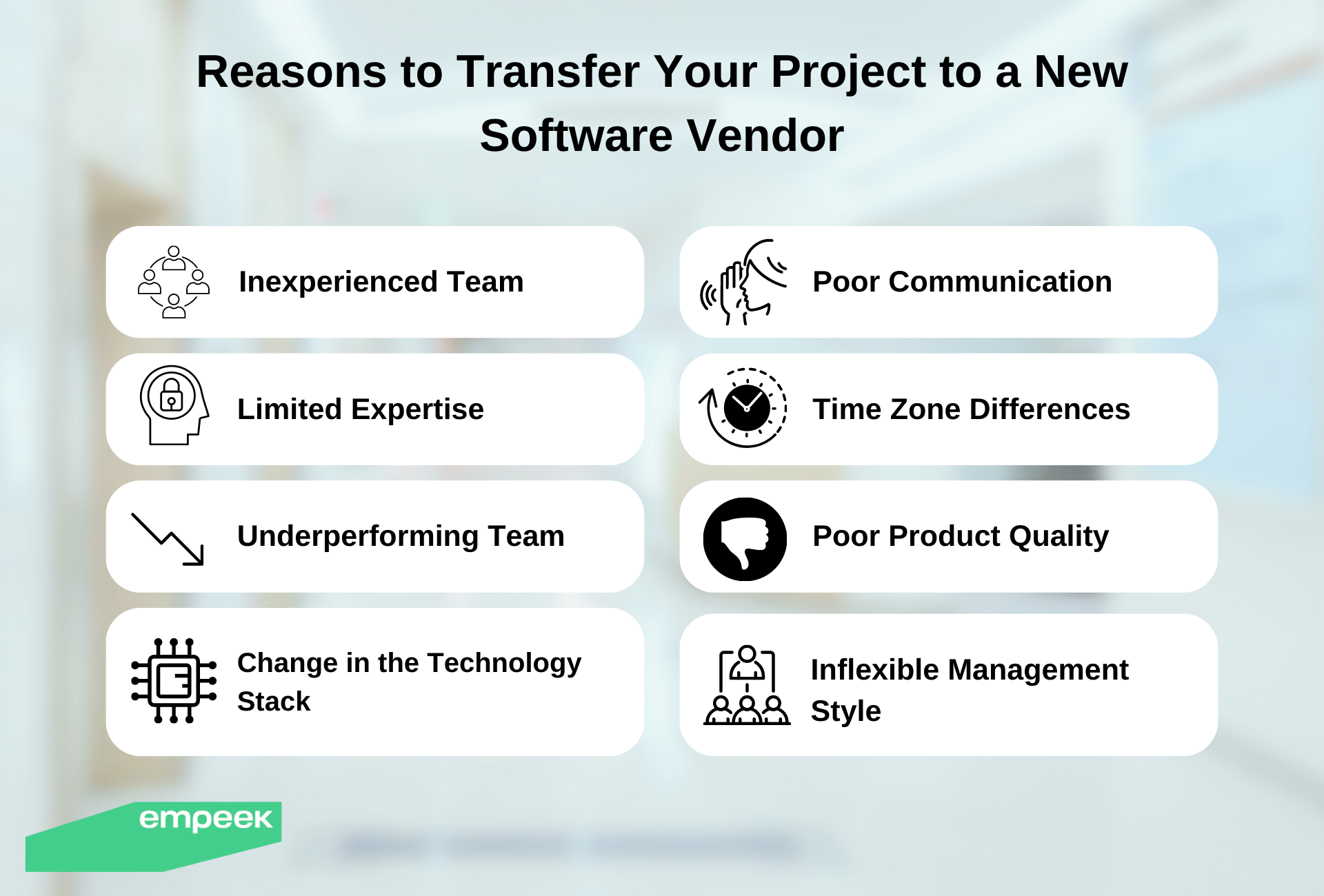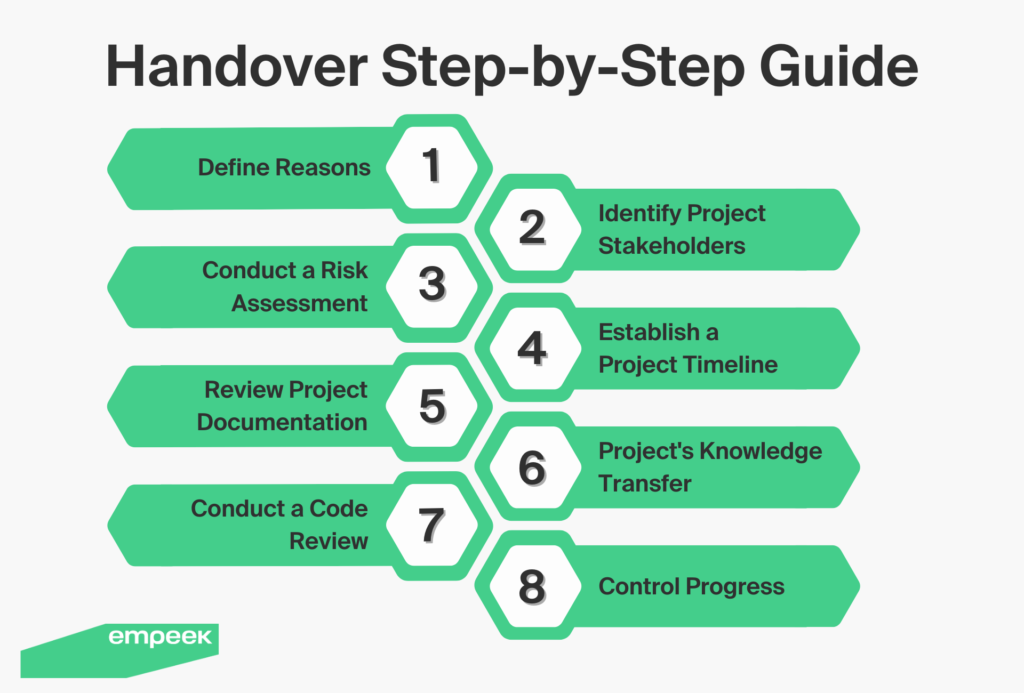Effective management of IT project handoff process is crucial when transitioning to a new vendor. Mishandling this phase can result in significant setbacks and financial burdens. In this article, we will discuss common pitfalls during project handover and how to minimize the risk of costly errors and unnecessary delays.
Whether you are a business owner or a project manager, this article will help you prepare for a transition to a new software vendor, ensuring the uninterrupted progress of your project’s success. So, let’s dive in.
What Is IT Project Handover, And When Is It Needed?
IT project handover refers to the process of transferring ownership of a software project from one company to another. This transfer occurs for various reasons, including a lack of expertise, changes in cooperation terms, or failed development timelines.
Why You May Need to Transfer Your Project to a Different Software Vendor
In software development, businesses may find the need to replace its current team or move their projects to another software vendor for several reasons. Let’s briefly discuss each of the main ones.
| Inexperienced Team | The current team may lack the necessary experience to take the project to the next level. The client may perceive the team as incompetent in handling the project, resulting in a lack of trust. |
| Limited Expertise | A client may opt for a cheaper vendor to develop their minimum viable product (MVP). However, as the business grows, the chosen vendor may lack the expertise and experience required to handle the project’s complexities, such as developing an AI algorithm. |
| Underperforming Team | The current team may fail to meet the client’s expectations, resulting in project delays and slow progress. |
| Change in the Technology Stack | If the client decides to change their technology stack, the current vendor may lack the necessary expertise to support the new technology. There can be various reasons for this change, such as legacy modernization, migration to the cloud, or compliance with legal requirements. |
| Poor Communication | The current vendor may face communication issues with the client, including language barriers, slow response times to requests and changes, and an inability to grasp the bigger picture of the project. Consequently, as a client, you may encounter difficulties in working effectively with the current team. |
| Time Zone Differences | A software development company’s time zone may not align with the client’s needs, and it failed to establish an efficient process tailored to the client’s requirements. These issues can result in delays and miscommunications, further impacting the project. |
| Inflexible Management Style | The technical specialists might be capable, but the vendor’s management style might lack adaptability or flexibility to accommodate the client’s evolving needs. A sudden shift in the collaboration model can create problems in effectively addressing the changing requirements of the client. |
| Poor Product Quality | The current vendor delivers low-quality services, leading to cost overruns, delays, and the absence of essential functionalities. |

Main Problems You Can Face by Handing Over Your Project: Our Experience
Handing a software project to a new team can be challenging, fraught with potential pitfalls and obstacles. From communication breakdowns to a lack of expertise, many issues can arise. Here are the main ones:
Absence of An Expert To Onboard New Team Members
The absence of an expert to onboard new team members can hinder their understanding of the project and impact their ability to contribute effectively.
To mitigate this issue, you can implement the following actions:
- Create Detailed Documentation: Prepare comprehensive documentation that includes project requirements, design specifications, system architecture, and any other relevant information. This documentation will serve as a reference guide for the new staff members to understand the project.
- Conduct Knowledge Transfer Sessions: Organize knowledge transfer sessions where the existing team members, who possess a deep understanding of the project, can share their knowledge with the new team members. These sessions can include walkthroughs, code reviews, and discussions to ensure a smooth transfer of knowledge.
Unclear Business Logic And Model
It can lead to confusion and misunderstandings among the new team, affecting their ability to make informed decisions and develop the software accurately.
The lack of proper understanding among the new team members can indeed lead to confusion and misunderstandings, which can ultimately impact their ability to make informed decisions and accurately develop the software.
To address this issue, the following steps can be taken:
- Simplify the Communication: Foster an environment of open communication where all stakeholders, including the new team members, feel comfortable expressing their thoughts, concerns, and questions. This helps to clarify any ambiguities and ensure everyone is on the same page.
- Host a Regular Design Sessions: Organize regular meetings where the new team members can actively participate and gain a deeper understanding of the project’s business logic, system architecture, and overall objectives. A well-structured sessions provide opportunities for discussion, clarification, and alignment.
While it may take some time for the new team members to fully grasp the project, the investment in encouraging open communication and conducting regular design sessions will pay off in the long run. It enhances collaboration, reduces misunderstandings, and enables the team to make well-informed decisions throughout the software development process.
Lack of Ex-Team Expertise
The lack of expertise among the new team members can create knowledge and skill gaps, making it challenging for them to tackle complex technical issues and effectively approach the development process.
To mitigate this challenge, you can do the following:
- Establish Clear Expectations and Timelines: Define clear expectations and timelines for the handover process. This includes documenting the specific knowledge and skills that need to be transferred and setting deadlines for the completion of each phase. Clear expectations help in prioritizing the handover activities and ensuring a smooth transition.
- Provide Ongoing Support to the Old Team: Offer ongoing support to the existing team during the handover process. This support can be in the form of knowledge sharing sessions, mentoring, or assigning dedicated resources to assist with the transition. Motivate the old team members to actively participate in the handover by highlighting the importance of their contribution and recognizing their efforts.
Poor Communication
The lack of effective collaboration and misunderstandings between teams and business managers during the handover process can result in delays and hinder the progress and success of the project.
What to do?
- Establish open communication channels between all teams involved in the handover process. This includes drawing a clear lines of communication, such as regular meetings, status updates, and a designated point of contact for queries and concerns.
- Keep all stakeholders, including business managers, informed of the progress and any issues that arise during the handover process. Regularly share updates, milestones achieved, and potential challenges faced.
Outdated Technology
Working with outdated technology can impose limitations on the project’s capabilities and create compatibility and maintenance challenges for the new team.
To address this situation, the following steps can be taken:
- Conduct Thorough Due Diligence: Perform a comprehensive due diligence process to identify any potential issues associated with outdated technology. This includes assessing compatibility with modern systems, identifying maintenance challenges, and evaluating the impact on project scalability and performance.
- Identify Expertise Gaps: Collaborate with the new team to identify any gaps in their expertise related to the outdated technology. Understand their skill levels and areas that require further development to effectively manage the project.
Lack of Documentation
The lack of access to project documentation by the new team can hinder their understanding of the project, impede their ability to make informed decisions, and result in increased development time and potential errors.
To address this challenge, you must ensure all available project documentation can be accessed by the new team. Also, create a centralized repository for all project-related documents so the new team could contribute and update it on the go.
Step-by-Step Software Transition Plan
Transitioning from one software development company to another can be complex and challenging. A step-by-step vendor transition plan can ensure a well-organized and executed process, minimizing the negative impact on your business operations. This plan typically includes the following steps:
Step #1. Evaluate the Reasons For the Transition
Evaluating the reasons for the transition is crucial. This will help ensure the necessity of the handover and prepare the new team to handle the project.
Step #2. Identify Project Stakeholders
This includes the outgoing and incoming teams, the client, and third-party vendors. It is essential to establish clear lines of communication and ensure that everyone knows their roles and responsibilities in the project. This will help to avoid any misunderstandings or conflicts during the transition process.
Step #3. Conduct a Risk Assessment
Risk assessment involves project analytics, potential risks identification, and their likelihood and impacts assessment. Threats can come in many forms, such as technical issues, delays in the handover process, or miscommunications between teams. Once identified, risks should be prioritized based on their potential impact and likelihood.
Step #4. Establish a Project Timeline
Creating a project timeline is an essential step in a software transition plan. It involves identifying key milestones and deadlines that must be met during the handover process. This timeline should include all the critical steps, such as placing the new team, knowledge transfer, testing, and deployment. By establishing a clear and detailed project execution plan, all stakeholders can comprehensively understand the timeframe and their respective roles and responsibilities.

Step #5. Review Project Documentation
As part of the software project transition plan, it is essential to thoroughly review all project documentation to ensure that the incoming team understands the project requirements, design documents, and plans. This step is crucial to avoid misunderstandings or confusion during the transition process. Additionally, any missing or outdated documentation should be updated and made available to the new team to ensure a smooth handover.
Based on our experience, this step can be complicated. In our interactions with clients that are transitioning to us, we often encountered documentation issues. Insufficient or poorly maintained documentation is one of the most common reasons for changing vendors. This lack of documentation leads to gaps in knowledge and can result in delays. In such cases, we initiate the process of creating documentation from scratch and document everything as we progress. Subsequently, we review and enhance this documentation to ensure its completeness and accuracy.
Step #6. Conduct a Software Knowledge Transfer
During this step, the outgoing team plays a crucial role in transferring their knowledge and expertise to the incoming team. This knowledge transfer process is essential as it enables the incoming team to understand the project’s current state, identify areas for improvement, and anticipate potential issues or challenges during the transition.
However, we often encounter situations where responsible individuals for knowledge transfer are lacking. For instance, the lead developer may have left, there might not have been a proper project manager assigned, or the remaining team members may have significant knowledge gaps regarding the project’s history. In such cases, conducting a thorough code review with relevant engineers becomes the primary approach. Typically, this involves collaboration among front-end and back-end engineers, DevOps specialists, QA leads, business analysts, and project managers.
It is crucial to avoid relying on a single individual to possess all the knowledge. In doing so, the risk of losing valuable insights increases, and the business may suffer serious consequences.
Step #7. Conduct a Code Review
Now, we conduct a thorough source code review to identify any issues or areas of improvement. This can include identifying potential technical debt and refactoring opportunities.
Step #8. Control Progress
It’s essential to closely monitor the progress of the handover process to ensure everything is going according to the established plan. Regular status meetings can be conducted to check on the status of each milestone and identify any issues or roadblocks that may arise. Tracking key performance indicators can also provide valuable insight into the success of the handover process. By monitoring progress, stakeholders can make necessary adjustments to keep the handover process on track and achieve a successful software project transition.
How to Choose a Software Development Company Which is Right For You?
With so many options available, it can be overwhelming to know where to start. In this context, prioritizing your needs and expectations and carefully evaluating potential companies can help you make an informed choice that aligns with your goals and budget. Let’s overview the main factors to consider.
Your Needs
What are you looking to achieve, and what kind of software solution do you require? Understanding your priorities will help you find the right company to meet your needs.
It is okay to be overwhelmed with vendor choices, especially when the last experience wasn’t as expected initially. When speaking with potential vendors, give them a chance to share their views on definition and solutions of your needs. A company that took over projects like yours, will be able to give you a sense of clarity.
Communication
Good communication is critical for the success of any software development project. When selecting a company, it is important to prioritize those that have a transparent and open communication process and are responsive to your needs and concerns.
Here are a few points to consider when evaluating communication:
- How frequently do they reach out to you with questions?
- How quickly do they respond to your inquiries?
- What communication channels do they use? Examples include WhatsApp, Slack, and email.
- Who is involved in the communication process? It is a positive sign if the business analyst and project manager are engaged from the pre-sale stage.
- How are meetings structured? Pay attention to whether call agendas are clear, and all participants are informed of the purpose of the call.
- Do they provide a summary email after the call to ensure that all discussed points are captured?
The Company’s Background
Before hiring a software development company, doing your due diligence is essential. Talk to their past and current clients to understand their experience. This can give you valuable insights into their communication skills, development process, and overall quality of work.
Contracts
Before signing a software development company contract, it is crucial to understand all the terms and conditions. Reviewing sample contracts can provide insight into what to expect regarding issue resolution and payment terms.
Demo of Existing Functionality
To understand the company’s capabilities, ask for a demo of existing software solutions or portfolios they developed. This can help you evaluate their technical expertise.
Important Issues
During the hiring process, discuss any critical issues or concerns you have, such as what went wrong with previous development projects and how the company plans to handle these issues if they arise. This can help ensure that you are on the same page and avoid similar future problems.
Handover Process
Ask the company about its handover process, which will be vital if you switch vendors. Ensure they have a clear plan for transitioning the project to a new team.
Post-Project Support
Ensure that the company offers post-project support, which can be crucial in case any issues or bugs arise after the project is completed.
Development Approach
Ensure that the new company’s development approach aligns with your views on this process. Discuss your thoughts on methodologies, and determine if the company can accommodate your preferences or justify the new suggested approach.
Empeek’s Verified and Tested Project Handing Over the Checklist
Drawing from our experience, we have created a guided checklist that you can use when changing software development vendors. It is crucial to have a clear understanding of each item on the checklist and discuss it with both the new and current teams.
Define reasons for change – extremely important since we want to be efficient, right? We don’t want to make the same mistake twice.
Requirements & expectations – should include everything that bothers you, from cost and timeline to the team composition that is taking over your project.
Share responsibilities – who is responsible for what. Who is the ‘knowledge keeper’? Who documents knowledge?
“Knowledge keeper” responsible for all technical details, involved stakeholders, and other critical project information. This ensures the incoming team can quickly get up to speed and prevent potential roadblocks. Think of the knowledge keeper as a bridge between the outgoing and incoming teams, guaranteeing a smooth handover process.
- Learn properly the transition plan
- Study the legal aspects of a new cooperation
- Knowledge and data transfer:
- Documentation
- Code
- Passwords
- Licenses
- Access to a production environment
- Reports
- Communication
- Tools to use for project management, chat, calls
- Frequency of meetings (very important, since can be charged differently)
The list can be much longer and customized according to each case.
Wrapping Up
As you can see, successfully handing over a software project to a new team is a complex process that requires careful planning, communication, and collaboration. Following the steps outlined in this article and using the checklist provided can minimize the roadblock that postpones the transition process. Remember to prioritize knowledge transfer, documentation, and clear communication, and don’t hesitate to seek outside help or advice if needed.

Are You About To Switch Your Software Development Provider? Don’t Hesitate To Seek Our Help
Get Advice







